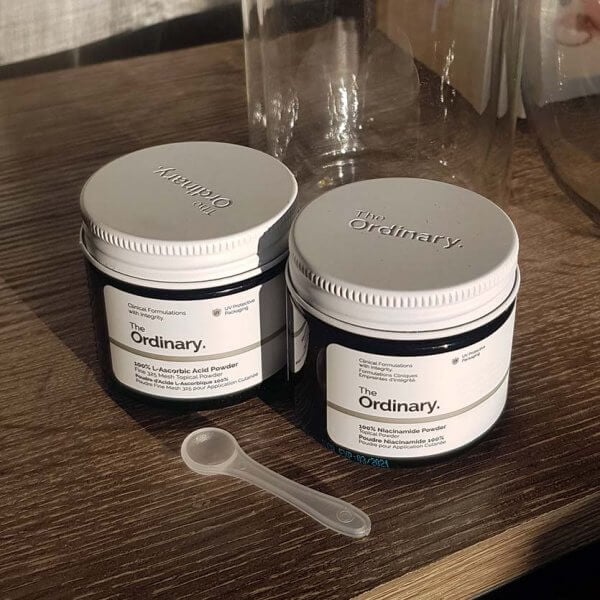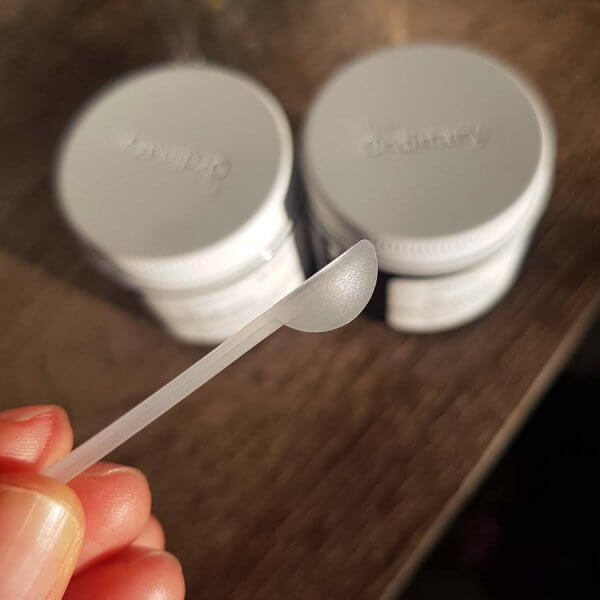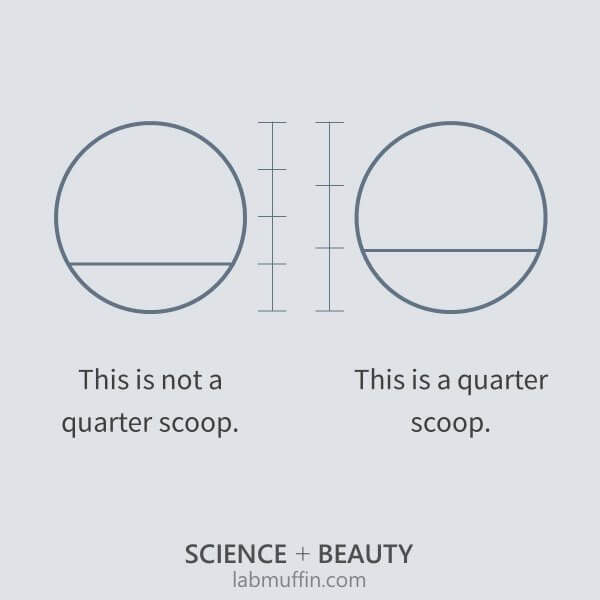Ordinary Vitamin C Powder
Affiliate Disclosure: I receive a small commission for purchases made via affiliate links.
There are a lot of The Ordinary products I really like (the Squalane Cleanser, Natural Moisturising Factors and Glycolic Acid 7% Toning Solution are some of my favourites), and I really appreciate the fact that they (and Deciem in general) really emphasise understanding the ingredients in skincare. But their powders are something I've never really been on board with. There was the 100% L-Ascorbic Acid Powder, and now they've released the 100% Niacinamide Powder – here's why I don't recommend them.
Video is here on YouTube, keep scrolling for the written version.
Formulation
The Ordinary has always had products with minimal formulation. This drastically cuts down product development and production costs, which is a large part of why their products are so cheap. For simpler products, like water-based products that are essentially a solution (hydroxy acid products) this is probably fine, but with emulsions and unstable actives it's questionable whether the product works – whether the actives go into your skin, or whether there's still a useful amount of active actually there by the time you open your bottle for the 40th time. Still, it's a good way to make ingredients accessible, even if they're not formulated to necessarily work.

With the powders, there's zero formulation, which makes it even more questionable whether it'll work – which I can forgive somewhat since most brands don't test their products on skin. For the niacinamide powder, The Ordinary do recommend that you mix it only with a water-based product at pH 5.1-7.0. I really doubt that most people will check the pH of their products, but The Ordinary do have a list of their suggested products for mixing.
But with these powder products there's also the much bigger problem of safety.
Percentage-chasing
I think there's a bit of a trend in skincare to chase high percentages. The idea that low concentrations are useless, that honest skincare brands will tell you the percentages of all their active ingredients, that active ingredients need to be at the top of the ingredients list if a product's worth buying – these concepts are common in skincare. The Ordinary has encouraged this, at least inadvertently, by listing all their active ingredient percentages and in some cases, putting far higher percentages in their products than their competitors.
But high percentages aren't always necessary. If you buy cosmetic ingredients from an ingredient supplier, they usually tell you the recommended percentage to use, with an upper limit for safety – niacinamide, for example, is recommended at 0.5-5% and ascorbic acid is recommended at 5-15%.
That's not because they're trying to trick you. If you think about it, ingredient suppliers would sell more product if they convinced cosmetic formulators to use a higher percentage. It's because studies have already found fantastic effects at these lower levels – in fact, the higher levels have never actually been tested in scientific studies. The risks of side effects that often come with higher levels aren't worth it for a slightly higher benefit.
An analogy is food (I love food, there's going to be a lot of food analogies here). If you like pepper, a bit of pepper is good. A bit more might be better. But too much pepper is awful.
You'll notice that in skincare products, concentrations higher than the recommended amounts are regularly used. On the one hand this means that maybe it'll compensate for a suboptimal formulation, or if some of the active degrades before it gets to you. But on the other hand, the recommended percentages are based on toxicological studies.
You'll often hear from mythbusting science communicators like me and Jen of The Eco Well that ingredients, at the concentrations used in beauty products, are safe. The important part here is at the concentrations used in beauty products . If there's too much, it might not be fine – toxicologists have analysed the safety based on common concentrations. If you have 75% niacinamide in a product rather than the recommended 5%, it may very well not be fine.
The Cosmetic Ingredient Review's Safety Assessment of niacinamide has the following statement:
Based on the available data, the CIR Expert Panel concludes that Niacinamide and Niacin are safe in the current practices of use and concentration in cosmetic products.
The highest concentration products covered in the review was 3% (the data was from 2001 – there's clearly been a considerable increase since then). For ascorbic acid (highest concentration in products considered in the review was 10%), and there's a similar statement:
Based on the available data contained in this report, the CIR Expert Panel concludes that L-Ascorbic Acid [… is] safe as used in cosmetic products.
These safety reviews usually include a wide margin of error for long-term severe health effects, so if you use multiple products with 5% niacinamide or 10% ascorbic acid you're very unlikely to be risking cancer or anything – plus there's the fact that these are vitamins that humans have been using safely for all of history.
But one of the things that can happen quite easily with a slightly higher concentration than normal is irritation. In the CIR assessment of niacinamide, the highest concentration used for irritancy studies was 20%. For ascorbic acid, it's 10%. Most of the studies on these ingredients that have found beneficial effects have been performed on <5% niacinamide and <10% ascorbic acid, so there's no reliable evidence that higher percentages work better. There's actually a study that suggests that going above 20% ascorbic acid won't give more benefits but will increase irritation.
Related post: What Is Niacinamide and What Does It Do in Skincare?
Unfortunately The Ordinary's products don't tell you the right amount to measure to get 5% niacinamide or 10% ascorbic acid. In fact, the guidance on amount is very vague:
Which is probably my biggest issue with the powders…
You can't measure tiny amounts accurately
The "small amount" that you're instructed to use for ascorbic acid is incredibly vague. Ask 5 different people to show you a "small amount" of powder, and you'll get 5 different answers.
With the niacinamide, the situation is a bit better: a quarter scoop of niacinamide powder (the scoop is provided). But this still has a lot of issues.

Volumetric measurements
Volumetric measurements of powders are never really accurate. We've seen this from everyday life. You get wildly different amounts of food in a loosely packed box of a leafy salad compared to a tightly packed one (and you always go back to the shop that does the tightly packed ones). Even when it's something relatively solid, it makes a big difference – a cup of whole strawberries vs a cup of finely diced ones, or a cup of loosely packed vs tightly packed flour.
With different powders, there won't be a consistent density – the smaller the particles, the more weight you can fit into the same volume (think strawberries). Even with the same ingredient, you can get different particle sizes, and even with the same container of powder, smaller particles will filter through to the bottom of the container so your first few scoops will have less material than your last few scoops.
That's why in proper formulations, everything is done by weight – that's what the percentage of an active ingredient refers to.
Now in my DIY Vitamin C serum recipe, I do give an approximate volumetric measurement. That's because I realise that not everyone owns a scale, so for practical reasons an approximate volumetric measurement is handy, especially if you've weighed it once before and you're using the same jar of product. There's also a very wide range of effective L-ascorbic acid concentrations, from 5 to 20%, so if you aim for a 10% concentration you have a 100% leeway either way, which is very hard to mess up if you're measuring grams of powder. Which is the main difference in safety here…
Related post: Easy (5 Minute) DIY Vitamin C Serum Recipe
Measuring per dose
In my DIY serum recipe, you're making about 20 mL of serum at a time. Making a full batch means that percentage errors are reduced – this is a big part of why I've never recommended measuring out powder per dose.
Let's say you want to apply a 10% LAA serum.
- If you're making 20 mL of serum, that means you're measuring out 2 grams of L-AA. If you accidentally add an extra 5 milligrams (about a matchhead size amount), that gives you a 10.025% L-AA serum, which is no big deal (commercially sold 10% serums probably regularly have more than this much extra).
- If you're mixing a single dose of serum – say 0.2 mL of serum (this is how much I usually apply – about 4-10 drops depending on how thick the serum is), then you need 2 milligrams of L-AA. If you accidentally add an extra 5 milligrams, you end up with a 35% L-AA serum. This is 3.5 times more concentrated than you were expecting, and well above the levels in any commercial vitamin C serum.
Additionally, with my DIY L-AA serum, you're adjusting the pH back up to a safe level by neutralising it with baking soda. There's no neutralisation step if you're adding "a small amount in the palm of your hand.
Related post: Is Sodium Hydroxide Safe in Beauty Products?
Measuring a "quarter scoop"
To make things a lot worse, while The Ordinary have included a scoop with the jar of niacinamide, the instructions say to include a quarter scoop for a face treatment. While this is miles better than the "small amount" recommended for L-ascorbic acid, it's still far too vague – a scoop that's a quarter of the size of the one provided would make a ton more sense. It's especially confusing because a quarter scoop isn't what you think it is when it comes to a hemisphere:

Circles are much smaller at the bottom, and it's compounded when it's a 3D circle (my new patented name for a sphere). It's just how geometry works, I don't make the rules.
There's also the fact you're not scooping at a 90 degree angle – you're going to be scooping out powder at a horizontal, so it's even harder to eyeball. I'm guessing it was too hard to source a scoop that was a quarter of the given size – alternatively (but surely not?) it could be to place more responsibility back on the customer if any lawsuits were to happen.
pH
On top of the wildly variable amounts of niacinamide and L-ascorbic acid you'd be applying on your face, there's the issue of pH.
For niacinamide, this is a minor issue in terms of safety – the product might not be effective, but niacinamide is pH-neutral so it won't burn your face off.
For L-ascorbic acid… well, it's an acid. Acids are acidic – they donate H+ in solutions so you end up with a lower pH.
With my DIY L-AA serum, you adjust the pH back up to a safe level by neutralising it with baking soda. There's no neutralisation step if you're adding "a small amount in the palm of your hand". With a 10% solution you're looking at a pH of around 2. With a possibly much higher percentage that you've mixed in your hand, it might be even lower. That's burn-your-skin-off territory.
Verdict
I really don't like doing highly negative reviews of products – in general, I think most products will be useful for someone, somewhere, and as I said, there are lots of Deciem products that I think are really fantastic. But in this case I really do think there's a safety issue with these products and how you're told to use them. There's a very good reason pure ingredients aren't marketed to consumers this way, even though sticking raw materials in jars and selling them would be extremely easy for anyone to do.
(Also, the L-ascorbic acid powder isn't very good value – 250 g of L-ascorbic acid from iHerb is $9.90 USD, which works out to be 80 cents for the 20 g in The Ordinary's $5.80 jar.)
There's a healthy dose of science-washing going on here, and I think it's important for customers to realise why playing chemist in the palm of your hand without doing the important things that actual chemists do (looking at the safety and efficacy data, calculating the formula, proper weighing, pH-adjustment) might not be the best idea.
Related post: Scientism or "Science-Washing" in Beauty
It's also a bit frustrating to see people applaud the launch of these powders, while at the same time criticising products for being "unsafe" when they use ingredients (alcohol, fragrances, dyes) at levels that are safe according to actual toxicological considerations. Marketing is something to be aware of, whether it comes from organic/natural brands or "sciencey" brands.
References
Cosmetic Ingredient Review Expert Panel, Final report of the safety assessment of niacinamide and niacin (open access), Int J Toxicol2005, 24 Suppl 5, 1-31. DOI: 10.1080/10915810500434183
Elmore AR, Final report of the safety assessment of L-ascorbic acid, calcium ascorbate, magnesium ascorbate, magnesium ascorbyl phosphate, sodium ascorbate, and sodium ascorbyl phosphate as used in cosmetics (open access), Int J Toxicol 2005, 24 Suppl 2, 51-111. DOI: 10.1080/10915810590953851
Pinnell SR et al., Topical L-ascorbic acid: percutaneous absorption studies, Dermatol Surg 2001, 27, 137-142. DOI: 10.1046/j.1524-4725.2001.00264.x
These products were provided for review, which did not affect my opinion. This post also contains affiliate links – if you decide to click through and support Lab Muffin financially (at no extra cost to you), thank you! For more information, see Disclosure Policy.
Source: https://labmuffin.com/why-i-dont-recommend-the-ordinarys-niacinamide-and-l-ascorbic-acid-powders/

0 komentar:
Posting Komentar